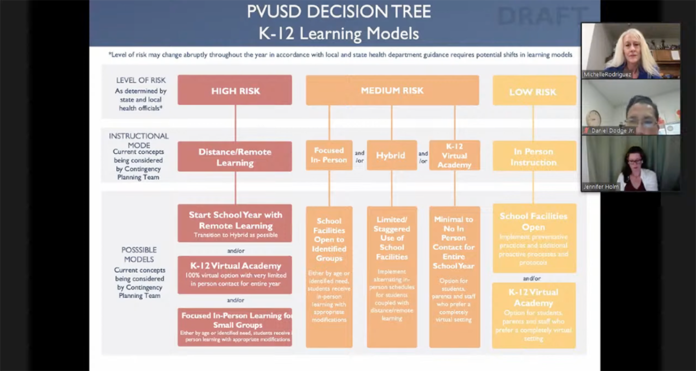WATSONVILLE—Many students unable to return to class when school starts on Aug. 14 due to Covid-19 restrictions will attend a virtual academy, an all-online option created by Pajaro Valley Unified School District as it plans for the coming academic year.
The PVUSD Board of Trustees on Wednesday heard the district’s tentative plans for reopening, a comprehensive list that outlines a wide range of topics that must be considered before classes start.
Starting today and lasting through June 26, the public is invited to share its thoughts about the plan. To see the details and provide feedback, visit bit.ly/3e9UENz.
“This is an opportunity for the community for the next week or so to be able to really offer us some feedback,” PVUSD Superintendent Michelle Rodriguez said.
The plan will come back to teachers’ and school employees’ unions for review, and a final draft will be available for the public on July 13.
Divided into three levels of risk—High, Medium and Low—the plan outlines whether—and how—students will attend classes.
Rodriguez described the plan as a “decision tree,” and said that it could change throughout the year if Santa Cruz County Health Officer Gail Newel changes the current risk level.
Because Newel has declared the county to currently be in the high-risk category, only students from transitional kindergarten through third grade will likely return to class for two days per week, in groups of no more than 12. Those students will engage in online learning for the remaining days.
All students in grades 6-12 will engage in distance learning, and those in grades 4-5 will see a combination of distance learning and a small amount of classroom time.
All students will be given prepackaged meals provided by the district, and students will not be allowed to bring their own lunches.
If Newel moves the county to the medium-risk category, 6-12 grades will be allowed to return in limited numbers.
All students will have their temperatures taken before entering campus, and will wash their hands at a portable station. In addition, they will be required to wear masks, and social distancing measures such as having their desks spaced six feet apart will be enforced.
Depending on their needs, some students, such as those in special education, could have in-person instruction, Rodriguez said, but those would have to be in groups of fewer than 12.
More than a dozen people sent emails to be read at the virtual meeting. Some urged the trustees to keep schools closed entirely and others asked them to return to class.
Watsonville High School teacher Abel Mejia expressed concern that the social distancing requirements, small class sizes and mask-wearing will be challenging to uphold at the school, where students, parents and staff are accustomed to working together side by side should high school students eventually return to class.
“Young adults act as magnets wanting to be near their friends as often as possible,” he said.
Trustee Jennifer Schacher pointed out that the decisions will have wide-ranging decisions that could change the face of education for years to come. She also said that, with a potential $20 million budget shortfall, implementing the measures will be challenging.
“We don’t know what the first day of school will look like or bring, but we do know it won’t be the same,” she said.











